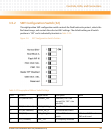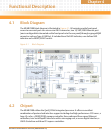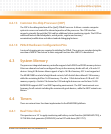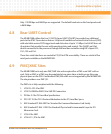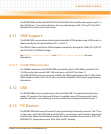
Functional Description
MVME2500 Installation and Use (6806800L01H)
67
4.6 SPI Bus Interface
The enhanced serial peripheral interface (eSPI) allows the device to exchange data with
peripheral devices such as EEPROMs, RTC, Flash and the like. The eSPI is a full-duplex
synchronous, character-oriented channel that supports a simple interface such as receive,
transmit, clock and chip selects. The eSPI receiver and transmitter each have a FIFO of 32 Bytes.
P20x0 supports up to four chip selects and RapidS full clock cycle operation. It can operate both
full-duplex and half duplex. It works with a range of 4-bit to 16-bit data characters and is a
single-master environment. MVME2500 is configured such that the eSPI can operate up to 200
MHz clock rate and can support booting process.The firmware boot flash resides in the P20x0
eSPI bus interface.
4.6.1 SPI Flash Memory
The MVME2500 has two 8 MB onboard serial flash. Both contain the ENV variables and the U-
Boot firmware image, which is about 513 KB in size. Both SPI flash contain the same
programming for firmware redundancy and crisis recovery. The SPI flash can be programmed
through the JTAG interface or through an onboard SPI flash programming header.
For information on U-boot and ENV Variables location see, Flash Memory Map, Table 5-2 on
page 82.
4.6.2 SPI Flash Programming
The MVME2500 has three headers: a 10-pin header for SPI Flash programming, an 80-pin
header for the JTAG connectivity and a 20-pin JTAG header for ASSET hardware connectivity.
The following options are used to program the onboard flash:
Using onboard SPI header - The MVME2500 uses the 10-pin header with a Dual SPI Flash in-
circuit programming configuration. The pin connection is compatible with DediProg SPI
Unversal Pin Header.
Using 60-pin external JTAG header - An external JTAG board with a JTAG multiplexer is
compatible with the MVME2500 and can be attached using an external cable. It can be
used to update the boot loader in the field. Using this method, programming can be done
through the JTAG interface or by using the dedicated SPI Flash programming header on the
JTAG board.



